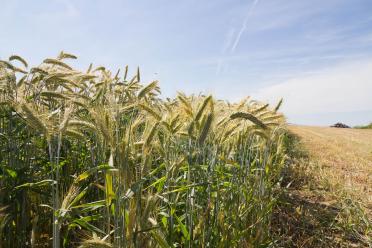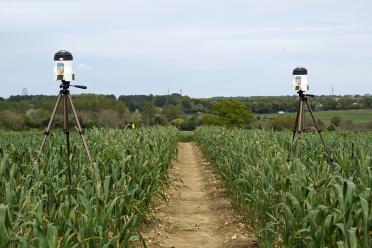United Kingdom
2 August 2024

Farmers can be warned about the appearance of potentially devastating crop pathogens in near real-time, thanks to technology that collects and sequences the air around their fields.
New research suggests the approach, developed at the Earlham Institute and Natural History Museum, could soon replace existing methods for detecting infection, which look for visible symptoms on the plants - at which point it is often too late.
With agricultural systems under continual threat from wind-borne diseases the ability to rapidly detect and respond to specific pathogens would transform the use of fungicides, improve sustainability, and strengthen global food security.
All living organisms shed fragments of their DNA into the environment, which provides opportunities to identify and monitor biodiversity from the traces of biological material in the air.
Researchers at the Earlham Institute and Natural History Museum have developed a revolutionary approach to benefit from this phenomenon - AirSeq.
AirSeq starts by pulling thousands of litres of air through a filter to capture any biological material. A number of steps are then taken to extract DNA from cells and prepare these fragments for sequencing, before cutting-edge software profiles the sequences to match each piece to an organism.
To demonstrate the accuracy of AirSeq, the researchers first tested their approach in a wind tunnel. By releasing increasing concentrations of Bacillus thuringiensis spores at set time intervals, the team were able to compare the relative abundance detected in the sequenced samples from their device.
They were able to see a clear increase in the relative abundance of B. thuringiensis, mirroring the release of higher concentrations over time.
The next step was to demonstrate AirSeq’s ability for biodiversity monitoring, and tracking species of interest, in an agricultural setting. The team captured air for an hour, three times a week over almost seven weeks, in a field where wheat, barley, and peas were growing.
From the sequenced biological material they captured, they were able to detect and record the relative abundance of viral, bacterial, and eukaryotic organisms - which included known crop pathogens and insects such as aphids.
The findings show that AirSeq can accurately recover, sequence, and match the DNA to a pathogenic species of interest. It is also able to track the relative abundance of each species over several weeks, which could be used to monitor the efficacy of any interventions.

Air samplers set up at the John Innes Centre Field Trials at Church Farm in Bawburgh, Norfolk.
Dr Richard Leggett, study author and Group Leader at the Earlham Institute, said: "We believe this is the first time anyone has carried out whole genome sequencing of the air in an agricultural setting. People have tested for specific pathogens but never sequenced the whole air community - and repeated this over time - to see everything they've captured.
"We've shown that this approach allows you to monitor agriculturally significant pathogens over time. It means we can arm farmers with the data they need to prevent crop losses.”
The technology represents a potentially huge shift in crop disease management, leveraging advanced DNA sequencing. This innovation not only promises early detection capabilities but also aims to empower farmers with real-time insights to combat diseases efficiently and sustainably.
Professor Matt Clark, Research Leader at the Natural History Museum said, “At the moment, farmers spray their crops with fungicides to make their plants inhospitable to possible fungal infections, but as different crops are resistant to different pathogen strains, this isn’t always necessary.
“AirSeq can detect which spores are present and how abundant they are, which would allow farmers to see whether or not they need to use fungicides. This means farmers can spray their crops more efficiently, saving them money and promoting more sustainable farming.”
The team is working to evolve AirSeq into a portable, field-ready device that continuously monitors the air for pathogens - bolstering food security as climate change intensifies disease pressures on crops.
Beyond mitigating losses, the technology offers a pathway to sustainable agriculture, minimising chemical inputs and mitigating risks associated with fungicide resistance.
Future research from the Earlham Institute and the Natural History Museum will advance AirSeq's sensitivity and usability. Together, the collaborators remain committed to harnessing the innovation for a more resilient, sustainable agricultural future - and the detection of other airborne diseases which threaten us and our environment.
“We’ve also continued to develop the technology for applications beyond agriculture,” added Dr Leggett. “That includes a recent project to detect human pathogens in urban environments, which combines AirSeq technology with bespoke software for reliable identification of biological threats.”
The new research paper ‘Measuring air metagenomic diversity in an agricultural ecosystem’ is published in Current Biology.